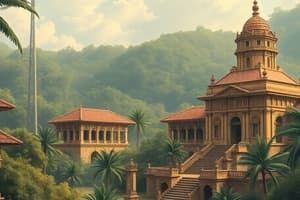Podcast
Questions and Answers
What type of natural features is Guatemala known for?
What type of natural features is Guatemala known for?
volcanoes, mountains, and beaches
How deep is Lake Atitlán?
How deep is Lake Atitlán?
900 feet (300 meters)
Which of the following is the capital of Guatemala?
Which of the following is the capital of Guatemala?
- Antigua Guatemala
- Guatemala City (correct)
- Belmopan
- Tikal
The Congress members in Guatemala serve a six-year term.
The Congress members in Guatemala serve a six-year term.
When was Guatemala's constitution adopted?
When was Guatemala's constitution adopted?
Who built the Tikal temple?
Who built the Tikal temple?
Which century did the Spanish conquer the Maya?
Which century did the Spanish conquer the Maya?
What year did Guatemala gain independence from Spain?
What year did Guatemala gain independence from Spain?
What became an important economic activity in Guatemala under Spanish rule?
What became an important economic activity in Guatemala under Spanish rule?
What was the primary reason behind the establishment of the United Provinces of Central America?
What was the primary reason behind the establishment of the United Provinces of Central America?
Juan José Arévalo was the first president after Guatemala became an independent republic.
Juan José Arévalo was the first president after Guatemala became an independent republic.
What significant reform did Jacobo Arbenz push for during his presidency?
What significant reform did Jacobo Arbenz push for during his presidency?
Flashcards are hidden until you start studying
Study Notes
Geography
- Guatemala is known for its diverse geography, featuring mountains, volcanoes, and beaches along the Pacific Ocean and Caribbean Sea.
- The country has 30 volcanoes, with three still active; Pacaya volcano is the most active one.
- Lake Atitlán, formed by a volcanic eruption 84,000 years ago, is the deepest lake in Central America, reaching 900 feet (300 meters) deep and spanning 48 square miles (125 square kilometers).
- One-third of the population lives in highland villages with cooler climates, while the coastal lowlands are warm and humid.
- Guatemala borders Mexico, Honduras, El Salvador, and Belize, and its capital, Guatemala City, has about 1 million residents.
Government
- The Constitution of Guatemala was adopted in 1985 and amended in 1994, establishing it as a democratic republic.
- The government has three branches: legislative (Congress), executive (president), and judicial (Supreme Court).
- Members of Congress serve four-year terms, as does the president, who cannot be re-elected.
- The country is divided into departments, governed by governors, and municipalities managed by mayors.
History
- Evidence suggests that the first settlers arrived in Guatemala around 14,000 years ago, with recorded human presence dating back to 9000 B.C.
- The Maya civilization thrived from A.D. 250 to 900, with Tikal being a major city that housed around 100,000 people, later abandoned by A.D. 900.
- The Spanish conquered the Maya in the 16th century, leading to forced labor on plantations and significant population loss due to European diseases.
- Guatemala gained independence from Spain in 1821 and initially became part of the Mexican Empire until 1823.
Colonial Period
- Under Spanish rule, the capital was established in Antigua Guatemala, which flourished while rural areas remained underdeveloped.
- Economic activities included cacao and indigo production using Indigenous and African slave labor, with cochineal dye later becoming significant.
- Earthquakes in 1773 led to the capital being relocated to Guatemala City, which became the administrative hub for Central America.
Post-Colonial Period and Independence
- Inspired by the American and French revolutions, Guatemala, alongside Central America, achieved independence from Spanish control.
- The United Provinces of Central America was formed, with Guatemala as the political center until its dissolution in 1839.
- Following the collapse, Guatemala became an independent republic.
Independence to the 1950s
- From 1871 to 1944, various governments updated infrastructure but suppressed political freedoms.
- In 1944, a military coup enabled political reform, resulting in Juan José Arévalo's election as president who introduced labor rights and social security.
- Jacobo Arbenz became president in 1951, advocating for land reforms that threatened U.S. business interests, namely the United Fruit Company.
- In 1954, the CIA intervened to overthrow Arbenz due to fears of communism.
Studying That Suits You
Use AI to generate personalized quizzes and flashcards to suit your learning preferences.




